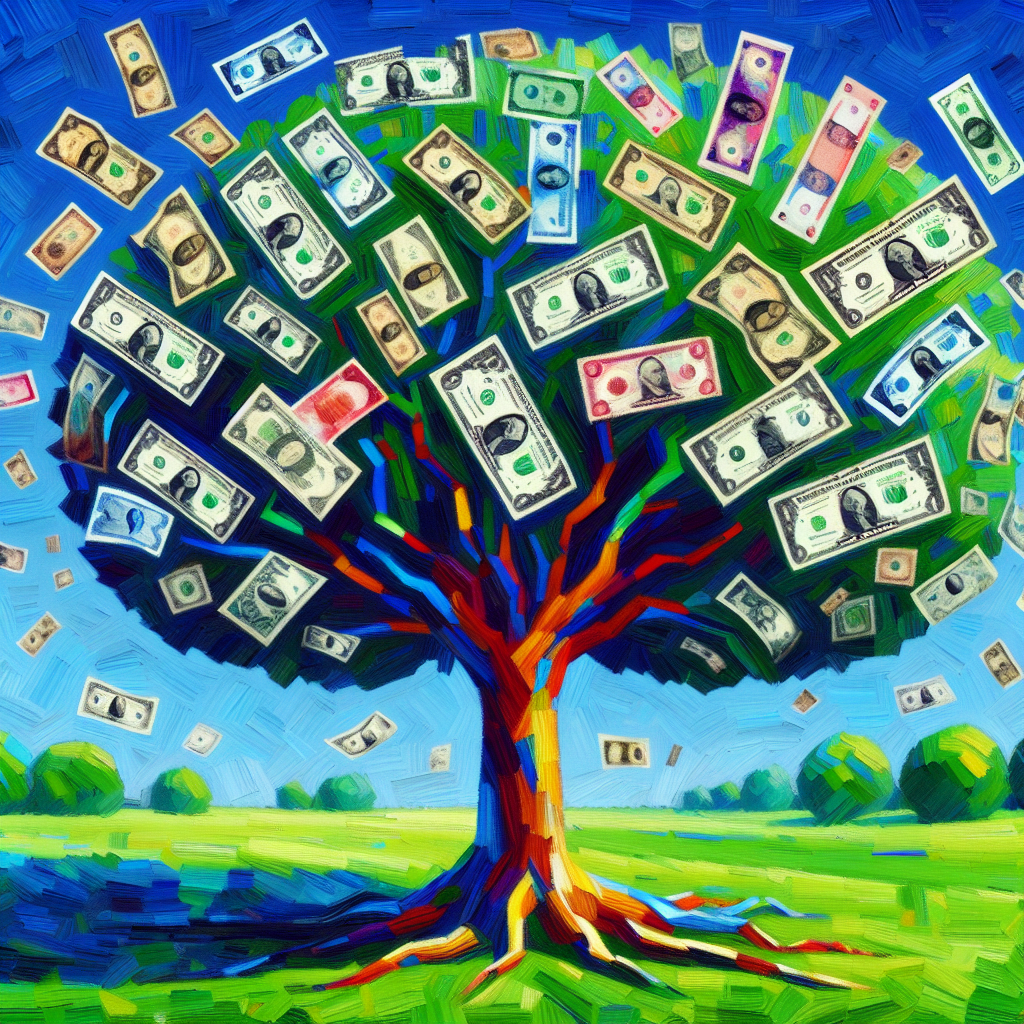The Money Tree

“Grow Your Wealth with Every Leaf – The Money Tree, Where Prosperity Takes Root.”
The Money Tree, also known as Pachira aquatica, is a tropical wetland tree native to Central and South American swamps. In popular culture, it is often associated with financial prosperity and is commonly used in the practice of Feng Shui. The tree is characterized by its braided trunk and lush, green leaves, which are said to symbolize growth and wealth. It has gained popularity as an indoor plant due to its aesthetic appeal and the belief that it brings good luck and fortune to its owners.
Unlock the secrets of financial growth with The Money Tree! Click here to learn more and transform your financial future today!
Cultivating Prosperity: The Money Tree Care Guide
The Money Tree, known scientifically as Pachira aquatica, is a symbol of financial prosperity and good fortune. This tropical wetland tree, native to Central and South American riverbanks, has gained popularity in the art of Feng Shui for its ability to attract wealth. Its braided trunk and lush, green leaves are not only aesthetically pleasing but are also believed to bring positive energy into homes and businesses. Cultivating prosperity through the care of a Money Tree requires understanding its natural habitat and replicating those conditions to the best of one’s ability.
To begin with, The Money Tree thrives in a well-draining soil mix that can hold some moisture without becoming waterlogged. A mixture of peat, pine bark, and perlite or sand is ideal for providing the necessary drainage and aeration. Overwatering is a common pitfall among Money Tree caretakers, as it can lead to root rot, a detrimental condition for the plant’s health. Therefore, it is crucial to water the plant only when the top inch of the soil feels dry to the touch. This method ensures that the roots receive adequate moisture without being submerged in excess water.
Moreover, The Money Tree prefers a humid environment, reminiscent of its native tropical conditions. In drier climates or during winter months when indoor heating can reduce humidity levels, it is beneficial to mist the leaves regularly or use a pebble tray filled with water to increase the surrounding humidity. This not only promotes leaf health but also prevents the edges from browning, a common symptom of low humidity.
Lighting is another critical factor in The Money Tree‘s growth. While it can adapt to low light conditions, it flourishes best in bright, indirect sunlight. Direct sunlight, especially during the harsh midday hours, can scorch the leaves, causing them to turn yellow and drop. Placing The Money Tree in a location where it receives dappled sunlight or is shielded by a sheer curtain can provide the optimal lighting conditions for its growth.
Furthermore, The Money Tree benefits from regular feeding during the growing season, which typically spans from spring to early fall. A balanced, water-soluble fertilizer applied once a month can provide the necessary nutrients for the plant to develop robustly. However, during the dormant winter months, it is advisable to reduce feeding to prevent the accumulation of excess fertilizer, which can harm the plant.
Pruning is also an essential aspect of Money Tree care. It not only maintains the plant’s shape and size but also encourages new growth. Snipping off any yellow or dead leaves and trimming back unruly branches can keep the plant looking tidy and vibrant. Additionally, if the braided trunk becomes too tight, gently loosening the braid can prevent damage to the bark and ensure the continued health of the tree.
In conclusion, The Money Tree is more than just an ornamental plant; it is a living emblem of prosperity that requires attention and care. By providing the right balance of water, humidity, light, nutrients, and pruning, one can cultivate not only a thriving Money Tree but also an atmosphere of abundance and well-being. As with all living things, patience and consistency are key. With proper care, The Money Tree can be a long-lasting and rewarding addition to any space, symbolizing the growth and prosperity that comes from nurturing and dedication.
Unveiling the Myth: The Money Tree and Financial Success

The Money Tree, a concept as old as time, has been deeply rooted in the collective consciousness of societies worldwide. This mythical plant, believed to sprout banknotes instead of leaves, has become a symbol of effortless wealth and prosperity. However, the reality of achieving financial success is far from the simplicity of watering a magical sapling. In this exploration, we unveil the myth of The Money Tree and delve into the true nature of cultivating financial well-being.
The allure of The Money Tree lies in its promise of instant gratification and the elimination of the need for hard work or financial acumen. It’s a comforting fantasy that resonates with the universal desire for a life free from economic worries. Yet, this seductive vision distracts from the principles that underpin genuine financial success. It’s crucial to recognize that wealth is typically the result of strategic planning, informed decision-making, and, often, a degree of risk-taking.
Transitioning from the myth to reality, it becomes evident that financial prosperity is akin to nurturing a real tree. Just as a sapling requires the right environment, consistent care, and time to grow, so too does one’s financial portfolio. The soil of this metaphorical tree is education. Understanding the basics of personal finance, including budgeting, saving, and investing, is foundational. Without this knowledge, attempts at wealth accumulation are likely to falter.
Moreover, the water and sunlight that nourish our Money Tree are analogous to the regular investments and exposure to financial opportunities that one must make. Consistent contributions to savings accounts, retirement funds, and other investment vehicles are essential for long-term growth. Similarly, staying informed about market trends and economic shifts can illuminate opportunities for financial advancement.
However, just as a real tree faces seasonal changes and environmental threats, the journey to financial success is fraught with challenges and uncertainties. Economic downturns, inflation, and personal setbacks can all impede growth. Resilience, therefore, becomes a critical trait. The ability to adapt to changing financial climates, to prune away unproductive investments, and to protect one’s assets against potential hazards is what separates those who thrive from those who merely survive.
It’s also worth noting that The Money Tree myth does not account for the diversity of financial goals and personal values. Financial success is not a one-size-fits-all concept. For some, it may mean the freedom to travel and experience the world, while for others, it could be the security of a robust retirement fund or the ability to provide for one’s family. Recognizing and honoring individual aspirations is a key component of a healthy financial plan.
In conclusion, The Money Tree remains a charming fable, but it is not a blueprint for financial success. The true path to wealth is less about finding a miraculous solution and more about embracing the principles of financial literacy, disciplined investment, and adaptability. By debunking the myth and focusing on the practical steps required to achieve economic well-being, individuals can plant the seeds for a prosperous future. Just as a gardener tends to their garden with patience and care, so must we tend to our finances with diligence and foresight. Only then can we hope to reap the bountiful harvest that The Money Tree symbolizes.
The Money Tree: Symbolism and Its Role in Feng Shui
The Money Tree, a concept steeped in symbolism and cultural significance, has long captured the imagination of those seeking prosperity and financial stability. This mythical tree, often depicted with its branches laden with coins or notes, serves as a powerful emblem of wealth and abundance. In the realm of Feng Shui, an ancient Chinese art of placement and energy balance, The Money Tree transcends its literal representation to embody a deeper meaning, harmonizing with the principles that govern the flow of chi, or life force, within a space.
The Money Tree‘s roots can be traced back to a fable about a poor farmer who stumbled upon a unique plant. Upon nurturing it, he discovered that it bore fruit in the form of coins, thus transforming his fortunes. This narrative underscores the belief that diligence and care can lead to prosperity, a notion that resonates with the core tenets of Feng Shui, which advocates for living in harmony with one’s environment to attract positive energy.
In Feng Shui, The Money Tree is often associated with the wood element, one of the five elements that are integral to its philosophy. Wood symbolizes growth, vitality, and renewal—qualities that are essential for financial success. The tree’s lush green leaves represent the vigor of life, and its capacity to generate wealth is likened to the natural growth of vegetation. By incorporating a Money Tree into one’s living or working space, practitioners of Feng Shui believe that they can stimulate the flow of chi in ways that foster financial growth and stability.
The placement of The Money Tree within a space is of paramount importance. According to Feng Shui principles, the southeast corner of a home or office is considered the wealth area. Positioning a Money Tree in this sector is thought to enhance its potency, acting as a magnet for wealth and prosperity. Careful attention is also given to the health of the plant, as a vibrant and well-maintained Money Tree is said to reflect the state of one’s finances. Conversely, a neglected or withering plant may symbolize financial neglect or mismanagement.
Beyond its physical placement, The Money Tree is also imbued with symbolic features that contribute to its effectiveness. The braided trunk, commonly seen in cultivated Money Trees, is believed to lock in good fortune, while the five leaves that typically adorn each branch are thought to represent the five elements of Feng Shui—wood, fire, earth, metal, and water—thereby ensuring a balanced and harmonious energy flow.
The Money Tree‘s role in Feng Shui extends to its psychological impact. The presence of this symbol can serve as a daily reminder of one’s financial goals and aspirations, fostering a mindset of abundance and positivity. This psychological reinforcement aligns with the Feng Shui belief that intention plays a critical role in shaping one’s reality. By nurturing The Money Tree, individuals are, in essence, nurturing their intentions and focusing their energies on the pursuit of wealth.
In conclusion, The Money Tree is more than just a decorative plant; it is a potent symbol that intertwines with the principles of Feng Shui to attract wealth and prosperity. Its role in this ancient practice is multifaceted, encompassing physical placement, symbolic representation, and psychological influence. By understanding and embracing the symbolism of The Money Tree, individuals can tap into the age-old wisdom of Feng Shui to create a space that not only looks inviting but also resonates with the energy of abundance and financial well-being.
Q&A
1. What is the concept of a “Money Tree” in popular culture?
A “Money Tree” in popular culture typically refers to a mythical or symbolic tree that produces money, such as coins or bills, instead of leaves or fruit. It represents the idea of effortless wealth or financial gain.
2. Is there a real plant called a “Money Tree”?
Yes, there is a real plant commonly known as the “Money Tree.” Its scientific name is Pachira aquatica, and it is often used in the practice of Feng Shui for its supposed ability to bring good luck and prosperity to its owner.
3. How do you care for a Pachira aquatica “Money Tree”?
To care for a Pachira aquatica, provide it with bright, indirect light and water it when the top few inches of soil are dry. Avoid overwatering, as this can lead to root rot. The plant prefers a humid environment and can benefit from occasional misting. It should be planted in well-draining soil and can be fertilized sparingly during the growing season.The Money Tree is often a metaphorical expression or a mythical concept that suggests the unrealistic idea of easily acquiring money without effort or work. It implies that wealth can be obtained without the usual means of earning it through labor, investment, or trade. The conclusion about The Money Tree is that it does not exist in reality; money typically requires effort to earn, and the concept serves as a cautionary tale against believing in easy riches or engaging in wishful thinking about financial gain.



